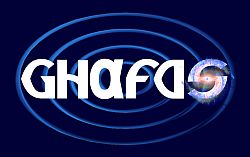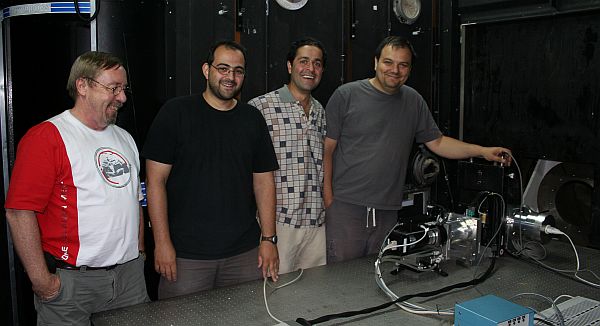
From July 6th to July 12th a new private instrument for the WHT, GHaFaS, saw its first run. The
acronym GHaFaS stands for Galaxy Halpha Fabry-Perot System, and gives an idea
of the nature and
the prime use of the instrument. It is a new generation FP interferometer,
whose
chief and powerful advantage over traditional systems which have been used on
telescopes is the
high sensitivity photon counting detector.
At the heart of the detector is a
micro-channel plate which gives a huge electron gain once the incoming photon
has been detected at
a photoelectric input surface.The system has very fast readout, no readout
noise, and
is especially advantageous for extended objects of moderate to low surface
brightness, where the absence of readout noise much more than compensates for
the rather lower quantum efficiency compared with a CCD.
The rapid readout
means that the whole spectral range of
the data cube can be covered in a few minutes, integrating for 10 seconds per
channel, so that even integrating the cube over long periods most of the
problems of sky variation are
diminshed.
As with all FP systems the product is a map with a emission line
profile on
each pixel, which can be converted into separate maps of integrated surface
brightness, of velocity
and of velocity dispersion for the whole object at once. The nearest analogue
would be a
21cm line map of a galaxy, but GHaFaS can obtain a map with velocity resolution
of
order 10 km/s and seeing limited angular resolution in a time of order 2 to 3
hours,
an order of magnitude shorter than the equivalent line maps in radio or
millimetre wave
lines, which in any case rarely reach resolution below 3 arcsec.
GHaFaS (which sounds like the Spanish word, "gafas", for a pair of glasses) is
operational on the GHRIL platform of the Nasmyth focus of the WHT. The
observing
group
opted not to use the optical derotator so as not to limit the field to less
than
2.5
arcminutes, and so be able to use the full 4 arcmin×4arcmin field (the derotator also
entails loss of light throughput).
Instead they rely on the system speed to record images so fast that the field
rotation could be taken out by software after observing. The effectiveness of
this procedure has
been proved during the run on the data cubes from a number of the galaxies
observed.
 |
Some members of the first light team. From left to right: C. Carignan, O. Hernandez, K.
Fathi, and J-L. Gach. GHaFaS is mounted at GHRIL, on one of the Nasmyth foci of the WHT [ JPEG ]. |
GHaFaS worked so smoothly during this first run that normal science data was being obtained from
half way through the first night. The group observed nearby
galaxies, interacting galaxy
pairs, more distant galaxies at over 100 Mpc away, and a planetary nebula, in
order to
put the instrument through its paces. In all cases sufficiently deep and
spectrally well
resolved data cubes were obtained.
A trial of the instrument to obtain
photometrically
calibrated Halpha images was also successful.
The group has already been
awarded
a second
run on the WHT in January.
The
instrument will be held at the WHT indefinitely. For the time being it will
be a
visitor
instrument, though the groups involved fully welcome collaborative proposals
from astronomers from other groups in other institutions, collaborating with
group members
who are experienced in its use. In the longer term, given the relative
simplicity
of operation of GHaFaS, the instrument could become a common-user instrument.
GHaFaS was produced by a team from the Université de Montréal, with
partners at the Observatoire de Marseille and the Instituto de Astrofísica de
Canarias.
More information:



